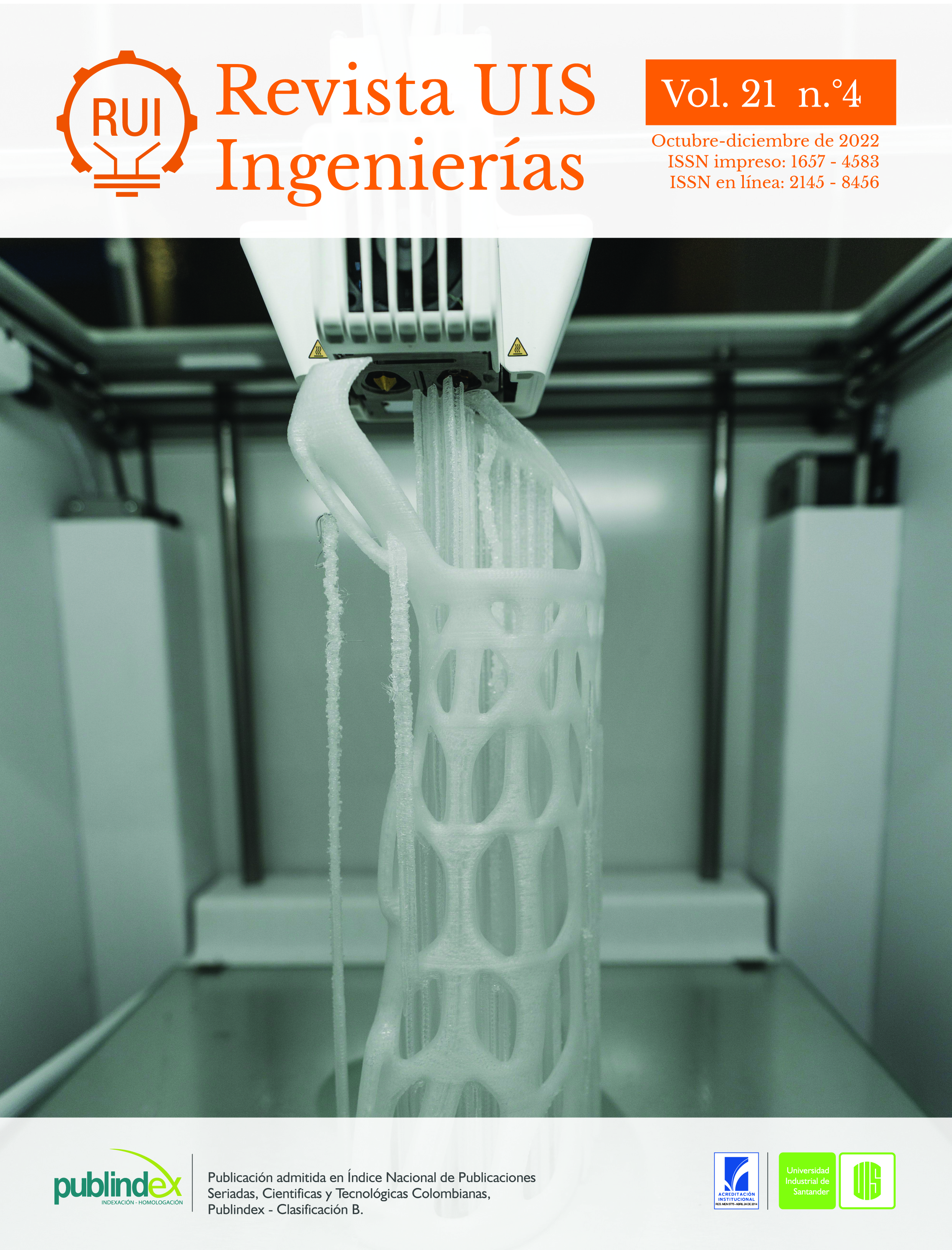Characterization of a fiber-reinforced geopolymeric concrete for its application in construction elements
Published 2022-10-23
Keywords
- geopolymeric concrete,
- fly ash,
- fiber-reinforced concrete,
- steel fiber
How to Cite
Copyright (c) 2022 Revista UIS Ingenierías

This work is licensed under a Creative Commons Attribution-NoDerivatives 4.0 International License.
Abstract
This article presents an analysis of the physical-mechanical characterization of a fiber-reinforced geopolymeric concrete, whose HCV matrix is made up of 90% fly ash (CV) and 10% ordinary portland cement (OPC), using as an alkaline activator a solution composed of silicate and sodium hydroxide (NaOH, Na2SiO3) and water. The reinforcement used was SikaFiber Xorex steel fibers incorporated into the matrix in proportions of 50 and 75 kg/m3. The HCV-50 mix reported a compressive strength of 26.77 MPa at 28 days of curing, classifying it as structural concrete according to NSR-10. At the same curing age, indirect tensile strength of 3.49 MPa, modulus of elasticity of 29.32 GPa, flexural strength of 5.15 MPa and toughness up to cracking deflection (δf) of 1971,9 N.mm were obtained. This mixture, considered optimal, was used in the manufacture of concrete slabs, which presented a rupture deflection δf of 4.45 mm, ultimate deflection of 16.15 mm, maximum load supported 15.6 kN, tenacity of 49464, 8 N.mm up to δf and 145847.3 N.mm up to 3 times δf. The fiber-reinforced geopolymeric material is also proposed to be used in the production of shotcrete (Shotcrete), and in the construction of lightweight tiles.
Downloads
References
- V. Afroughsabet, L. Biolzi, T. Ozbakkaloglu, “High-performance fiber-reinforced concrete: a review”, J. Mater. Sci., vol. 51, n.o 14, pp. 6517-6551, 2016, doi: https://doi.org/10.1007/s10853-016-9917-4
- L. Rogers, “La enorme fuente de emisiones de CO2 que está por todas partes y que quizás no conocías”, BBC News, vol. 17, p. 12, 2018.
- D. N. Huntzinger, T. D. Eatmon, “A life-cycle assessment of Portland cement manufacturing: comparing the traditional process with alternative technologies”, J. Clean. Prod., vol. 17, n.o 7, pp. 668-675, 2009, doi: https://doi.org/10.1016/j.jclepro.2008.04.007
- J. L. Provis, S. A. Bernal, “Geopolymers and Related Alkali-Activated Materials”, Annu. Rev. Mater. Res., vol. 44, n.o 1, pp. 299-327, 2014, doi: https://doi.org/10.1146/annurev-matsci-070813-113515
- N. Ranjbar y M. Zhang, “Fiber-reinforced geopolymer composites: A review”, Cem. Concr. Compos., vol. 107, p. 103498, 2020, doi: https://doi.org/10.1016/j.cemconcomp.2019.103498
- F. Liu, W. Ding, Y. Qiao, “Experimental investigation on the tensile behavior of hybrid steel-PVA fiber reinforced concrete containing fly ash and slag powder”, Constr. Build. Mater., vol. 241, p. 118000, 2020, doi: https://doi.org/10.1016/j.conbuildmat.2020.118000
- O. Rojas-Duque, L. M. Espinosa, R. A. Robayo-Salazar, R. Mejía de Gutiérrez, “Alkali-Activated Hybrid Concrete Based on Fly Ash and Its Application in the Production of High-Class Structural Blocks”, Crystals, vol. 10, n.o 10, Art. n.o 10, 2020, doi: https://doi.org/10.3390/cryst10100946
- Y. T. H. Cu, M. V. Tran, C. H. Ho, P. H. Nguyen, “Relationship between workability and rheological parameters of self-compacting concrete used for vertical pump up to supertall buildings”, J. Build. Eng., vol. 32, p. 101786, 2020, doi: https://doi.org/10.1016/j.jobe.2020.101786
- Toxement, “Guía básica para el concreto bombeado - PDF Descargar libre”. [En línea]. Disponible en: https://docplayer.es/203946647-Guia-basica-para-el-concreto-bombeado.html
- A. Koenig et al., “Flexural behaviour of steel and macro-PP fibre reinforced concretes based on alkali-activated binders”, Constr. Build. Mater., vol. 211, pp. 583-593, jun. 2019, doi: https://doi.org/10.1016/j.conbuildmat.2019.03.227
- M. M. Al-mashhadani, O. Canpolat, Y. Aygörmez, M. Uysal, S. Erdem, “Mechanical and microstructural characterization of fiber reinforced fly ash based geopolymer composites”, Constr. Build. Mater., vol. 167, pp. 505-513, 2018, doi: https://doi.org/10.1016/j.conbuildmat.2018.02.061
- M. Alshaaer et al., “Fabrication, microstructural and mechanical characterization of Luffa Cylindrical Fibre - Reinforced geopolymer composite”, Appl. Clay Sci., vol. 143, pp. 125-133, 2017, doi: https://doi.org/10.1016/j.clay.2017.03.030
- M. Amran et al., “Fiber-reinforced alkali-activated concrete: A review”, J. Build. Eng., vol. 45, p. 103638, 2022, doi: https://doi.org/10.1016/j.jobe.2021.103638
- N. Ranjbar, M. Mehrali, M. Mehrali, U. J. Alengaram, M. Z. Jumaat, “Graphene nanoplatelet-fly ash based geopolymer composites”, Cem. Concr. Res., vol. 76, pp. 222-231, 2015, doi: https://doi.org/10.1016/j.cemconres.2015.06.003
- K. T. Nguyen, N. Ahn, T. A. Le, K. Lee, “Theoretical and experimental study on mechanical properties and flexural strength of fly ash-geopolymer concrete”, Constr. Build. Mater., vol. 106, pp. 65-77, 2016, doi: https://doi.org/10.1016/j.conbuildmat.2015.12.033
- P. Nath, P. K. Sarker, “Flexural strength and elastic modulus of ambient-cured blended low-calcium fly ash geopolymer concrete”, Constr. Build. Mater., vol. 130, pp. 22-31, 2017, doi: https://doi.org/10.1016/j.conbuildmat.2016.11.034
- J. W. Cárdenas Pulido, “Desempeño en cortante por tensión diagonal sobre muretes reforzados basados en geopolímeros”, 2017.
- B. Singh, G. Ishwarya, M. Gupta, S. K. Bhattacharyya, “Geopolymer concrete: A review of some recent developments”, Constr. Build. Mater., vol. 85, pp. 78-90, 2015, doi: https://doi.org/10.1016/j.conbuildmat.2015.03.036
- S. Haruna, B. S. Mohammed, M. M. A. Wahab, M. U. Kankia, M. Amran, A. M. Gora, “Long-Term Strength Development of Fly Ash-Based One-Part Alkali-Activated Binders”, Materials, vol. 14, n.o 15, Art. n.o 15, 2021, doi: https://doi.org/10.3390/ma14154160
- W. G. Valencia-Saavedra, R. A. Robayo-Salaza, R. M. de Gutiérrez, “Propiedades de ingeniería de concretos híbridos activados alcalinamente basados en altos contenidos de ceniza volante: un análisis a largas edades”, Rev. UIS Ing., vol. 20, n.o 3, 2021, doi: https://doi.org/10.18273/revuin.v20n3-2021001
- A. Bhutta, P. H. R. Borges, C. Zanotti, M. Farooq, y N. Banthia, “Flexural behavior of geopolymer composites reinforced with steel and polypropylene macro fibers”, Cem. Concr. Compos., vol. 80, pp. 31-40, jul. 2017, doi: https://doi.org/10.1016/j.cemconcomp.2016.11.014
- “Manual de diseño y construcción de túneles de carretera, capítulo 8: Sistemas de sostenimiento”, Secretaría de comunicaciones y transportes de los Estados Unidos Mexicanos, 2016.

